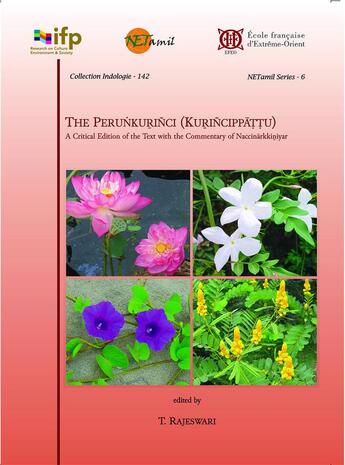Résumé:
The Perunkurinci ("The Great Poem of Kurinci"), better known under the title Kurincippattu, is traditionally counted among the "Ten Songs" (Pattuppattu), one of the two main subdivisions of the old Tamil Cankam corpus. Taking the form of a long monologue in which the female character's... Voir plus
The Perunkurinci ("The Great Poem of Kurinci"), better known under the title Kurincippattu, is traditionally counted among the "Ten Songs" (Pattuppattu), one of the two main subdivisions of the old Tamil Cankam corpus. Taking the form of a long monologue in which the female character's confidante addresses the foster mother, it deals at the same time with all aspects of the Akam theme of kurinci, the hilly landscape that provides a backdrop for the lovers' union. The text, newly edited on the basis of all surviving manuscripts, is published here along with its classical commentary by the great 14th-century scholiast Naccinarkkiniyar. An introduction presents the standards for the critical edition, and a complete word-index follows the presentation of the texts. Another special feature of this book is the extensive discussion and illustration of the ninety-nine species of flowers mentioned in the poem, which appear so pervasively in ancient Tamil literature but are often difficult to identify.
Le Perunkurinci (« Grand poème du Kurinci »), mieux connu sous le titre de Kurincippattu, est compté par la tradition indienne parmi les « Dix Longs Chants » (Pattuppattu) du corpus du Cankam, la littérature la plus ancienne préservée en tamoul. Composé sous forme d'un long monologue adressé par une confidente à la mère adoptive du personnage principal féminin, ce poème aborde tous les aspects du thème du kurinci, la région montagneuse où se produit, selon la convention propre à la poésie amoureuse tamoule (Akam), l'union des deux amants. Le texte fait ici l'objet d'une nouvelle édition critique sur la base de toutes les sources aujourd'hui accessibles, laquelle s'accompagne d'une nouvelle édition de son commentaire classique par le grand savant du XIVe siècle, Naccinarkkiniyar. L'introduction du volume présente la méthode adoptée pour l'édition critique, et un index complet des mots du poème suit l'édition des deux textes. Un autre aspect remarquable de ce livre est la discussion accompagnée d'illustrations des quatre-vingt-dix-neuf essences florales évoquées dans le poème, fréquemment mentionnées dans la littérature ancienne mais parfois difficiles à identifier.
About the author
Born in Nagercoil, T. Rajeswari studied Zoology and Tamil at the Universities of Madras and Kerala, and acquired a specialisation in manuscriptology from the International Institute of Tamil Studies in Chennai. She has taught in numerous institutions in Tamil Nadu, and after her retirement in 2004 she joined the EFEO in Pondicherry as a Research Fellow. Recently, she took an active part in the project of critical reedition of the old Tamil literary corpus initiated in the EFEO by Eva Wilden.
À propos de l'auteur
Née à Nagercoil, T. Rajeswari a étudié la littérature tamoule et la zoologie aux universités de Madras et du Kerala, avant de se spécialiser dans le domaine de la codicologie à l'International Insitute of Tamil Studies de Chennai.
Donner votre avis














